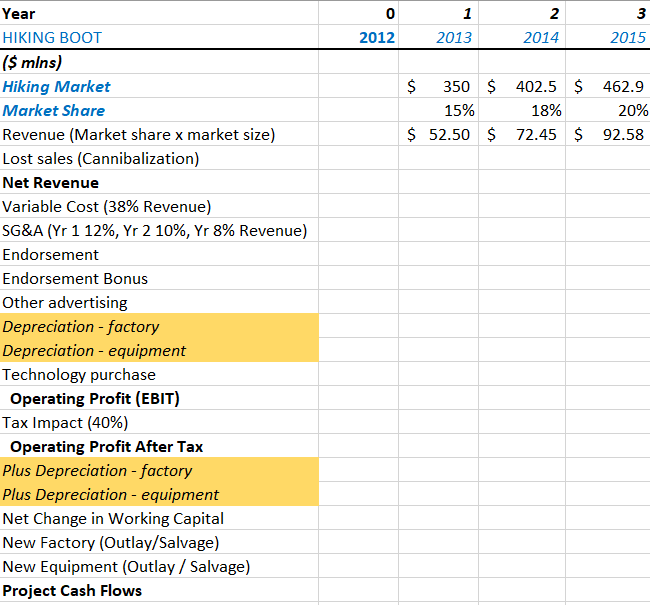Question
1. The life of the Persistence project would be only three years, given the steep technological learning curve for this new product line. 2. The
1. The life of the Persistence project would be only three years, given the steep technological learning curve for this new product line.
2. The wholesale price of Persistence (net to New Balance) would be $90.00.
3. The hiking segment of the athletic shoe market was projected to reach $350 million during 2013, and it was growing at a rate of 15% per year. New Balance?s market share projections for Persistence were: 2013, 15%; 2014, 18%; and 2015, 20%.
4. The firm would be able to use an idle section of one of its factories to produce the hiking shoe. A cost accountant estimated that, according to the square footage in the factory, this section?s overhead allocation would amount to $1.8 million per year. The firm would still incur these costs if the product were not undertaken. In addition, this section would remain idle for the life of the project if the Persistence project were not undertaken.
5. The firm must purchase manufacturing equipment costing $8 million. The equipment fell into the five-year MACRS depreciation category. Depreciation percentages for the first three years respectively were: 20%, 32%, and 19%. The cash outlay would be at Time 0, and depreciation would start in 2013. Analysts estimated the equipment could be sold for book value at the end of the project?s life.
I think I've been doing it right so far.... but what do I do with numbers 4 and 5? Please respond as soon as you reasonably can.

Year HIKING BOOT ($ mins) Hiking Market Market Share Revenue (Market share x market size) Lost sales (Cannibalization) Net Revenue Variable Cost (38% Revenue) SG&A (Yr 1 12%, Yr 2 10%, Yr 8% Revenue) Endorsement Endorsement Bonus Other advertising Depreciation - factory Depreciation - equipment Technology purchase Operating Profit (EBIT) Tax Impact (40%) Operating Profit After Tax Plus Depreciation - factory Plus Depreciation - equipment Net Change in Working Capital New Factory (Outlay/Salvage) New Equipment (Outlay / Salvage) Project Cash Flows 0 2012 1 2013 2 2014 3 2015 $ 350 $ 402.5 $ 462.9 15% 18% 20% $ 52.50 $ 72.45 $ 92.58
Step by Step Solution
3.48 Rating (158 Votes )
There are 3 Steps involved in it
Step: 1

Get Instant Access to Expert-Tailored Solutions
See step-by-step solutions with expert insights and AI powered tools for academic success
Step: 2

Step: 3

Ace Your Homework with AI
Get the answers you need in no time with our AI-driven, step-by-step assistance
Get Started


